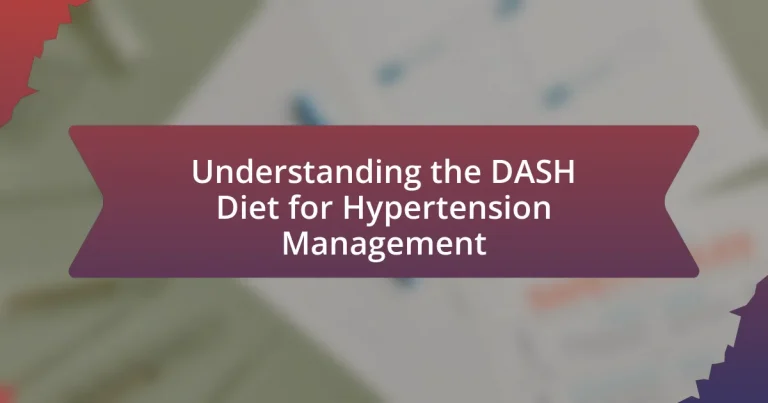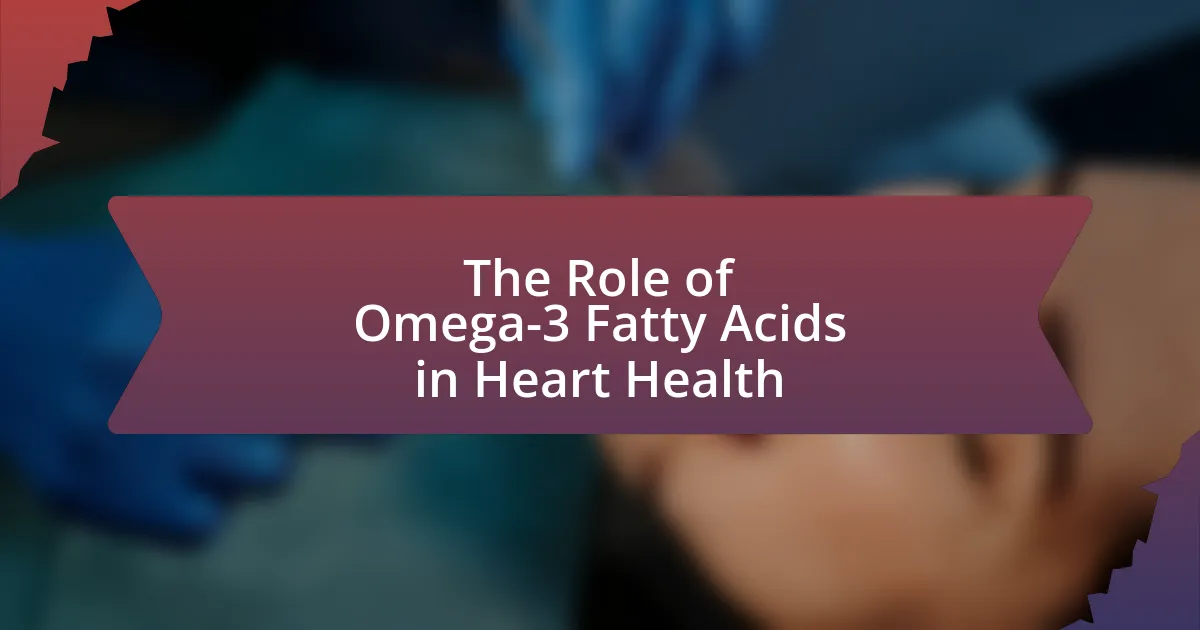The DASH Diet, or Dietary Approaches to Stop Hypertension, is a structured dietary plan aimed at reducing blood pressure and enhancing heart health through the consumption of nutrient-rich foods such as fruits, vegetables, whole grains, lean proteins, and low-fat dairy, while minimizing sodium intake. Developed in the 1990s through research funded by the National Institutes of Health, the DASH Diet has been shown to significantly lower systolic and diastolic blood pressure, as evidenced by multiple studies, including the pivotal DASH trial. Key principles of the diet include balancing macronutrients and focusing on whole foods, which contribute to various health benefits beyond hypertension management, such as improved cholesterol levels and better blood sugar control. The article will explore the development, effectiveness, and practical implementation of the DASH Diet, along with strategies for overcoming challenges and maintaining long-term adherence.
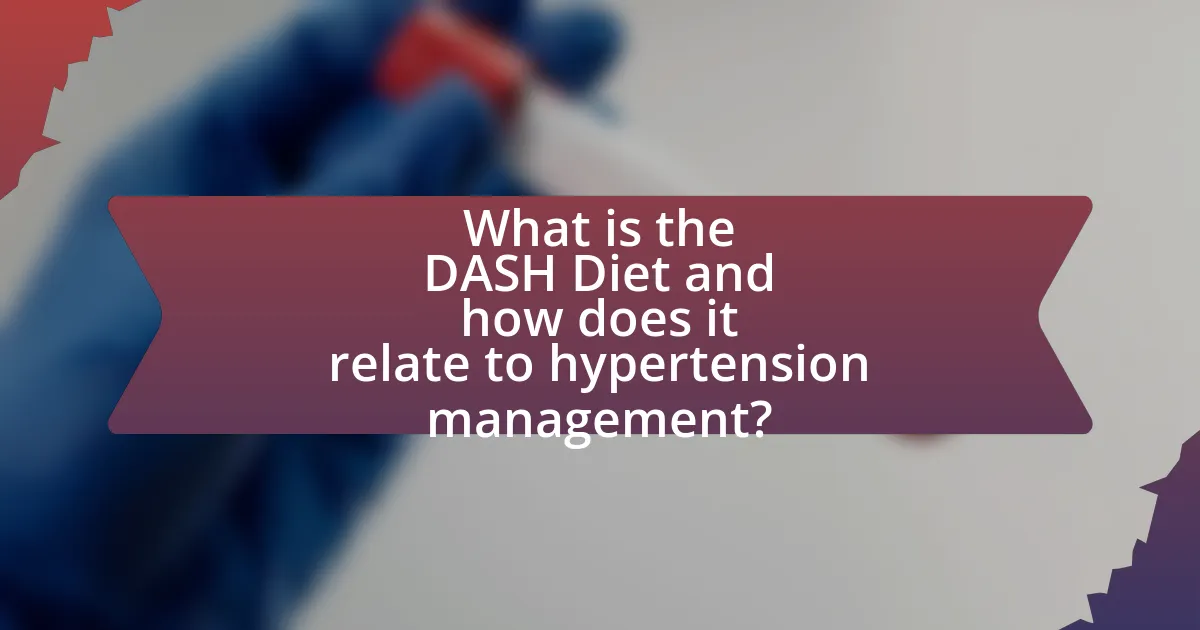
What is the DASH Diet and how does it relate to hypertension management?
The DASH Diet, or Dietary Approaches to Stop Hypertension, is a dietary plan specifically designed to help reduce blood pressure and improve heart health. This diet emphasizes the consumption of fruits, vegetables, whole grains, lean proteins, and low-fat dairy while minimizing saturated fats, cholesterol, and sodium. Research has shown that following the DASH Diet can lead to significant reductions in blood pressure; for instance, a study published in the New England Journal of Medicine found that participants who adhered to the DASH Diet experienced a decrease in systolic blood pressure by an average of 5.5 mm Hg and diastolic blood pressure by 3.0 mm Hg. Thus, the DASH Diet is directly related to hypertension management by providing a structured approach to nutrition that supports cardiovascular health.
How was the DASH Diet developed?
The DASH Diet was developed through research funded by the National Institutes of Health (NIH) in the 1990s, aimed at reducing hypertension. The study, known as the DASH (Dietary Approaches to Stop Hypertension) trial, involved a controlled feeding study where participants followed different dietary patterns, including a diet rich in fruits, vegetables, whole grains, and low-fat dairy. The results demonstrated that this specific dietary approach significantly lowered blood pressure compared to a typical American diet high in saturated fat and cholesterol. The findings were published in the New England Journal of Medicine, confirming the effectiveness of the DASH Diet in managing hypertension.
What research supports the effectiveness of the DASH Diet for hypertension?
The DASH Diet is supported by multiple studies demonstrating its effectiveness in reducing hypertension. One significant study is the DASH trial, published in the New England Journal of Medicine in 1997, which involved 459 participants and showed that those following the DASH Diet experienced a notable reduction in blood pressure compared to those on a control diet. Specifically, the systolic blood pressure decreased by 5.5 mm Hg and diastolic blood pressure by 3.0 mm Hg. Additionally, a meta-analysis published in the Journal of the American College of Cardiology in 2017 reviewed 15 studies and concluded that adherence to the DASH Diet significantly lowered blood pressure levels in both hypertensive and normotensive individuals. These findings collectively validate the DASH Diet’s role in hypertension management.
What are the key principles of the DASH Diet?
The key principles of the DASH Diet include a focus on whole foods, particularly fruits, vegetables, whole grains, lean proteins, and low-fat dairy, while reducing sodium intake to lower blood pressure. This dietary approach emphasizes nutrient-rich foods that are high in potassium, calcium, and magnesium, which are beneficial for heart health. Research published in the New England Journal of Medicine indicates that adherence to the DASH Diet can significantly reduce systolic and diastolic blood pressure, demonstrating its effectiveness in hypertension management.
What are the main components of the DASH Diet?
The main components of the DASH Diet include fruits, vegetables, whole grains, lean proteins, and low-fat dairy. This dietary approach emphasizes the consumption of at least four to five servings of fruits and vegetables daily, six to eight servings of whole grains, two or fewer servings of lean meats, poultry, or fish, and two to three servings of low-fat dairy products. Additionally, it encourages the reduction of saturated fat, cholesterol, and sodium intake, aiming for no more than 2,300 milligrams of sodium per day, or ideally 1,500 milligrams for greater health benefits. These components are designed to promote heart health and effectively manage hypertension, as supported by research published in the New England Journal of Medicine, which demonstrated that the DASH Diet can significantly lower blood pressure in individuals with hypertension.
What types of foods are emphasized in the DASH Diet?
The DASH Diet emphasizes fruits, vegetables, whole grains, lean proteins, and low-fat dairy products. This dietary approach is designed to reduce sodium intake and promote heart health, specifically targeting hypertension management. Research indicates that following the DASH Diet can lower blood pressure and improve overall cardiovascular health, as evidenced by studies published in the New England Journal of Medicine, which demonstrate significant reductions in systolic and diastolic blood pressure among participants adhering to this diet.
How does the DASH Diet recommend balancing macronutrients?
The DASH Diet recommends balancing macronutrients by emphasizing a higher intake of carbohydrates, primarily from fruits, vegetables, and whole grains, while moderating protein and fat intake. Specifically, the diet suggests that approximately 55% of daily calories should come from carbohydrates, 18% from protein, and 27% from fats. This balance supports heart health and helps manage hypertension by promoting nutrient-dense foods that are low in sodium and rich in potassium, magnesium, and fiber, which are beneficial for blood pressure control.
What are the expected outcomes of following the DASH Diet?
The expected outcomes of following the DASH Diet include significant reductions in blood pressure and improved heart health. Research indicates that individuals adhering to the DASH Diet can lower systolic blood pressure by an average of 5 to 6 mm Hg within a few weeks. This diet emphasizes the consumption of fruits, vegetables, whole grains, and lean proteins while reducing sodium intake, which contributes to these health benefits. A study published in the New England Journal of Medicine found that participants on the DASH Diet experienced a notable decrease in hypertension, demonstrating its effectiveness in managing blood pressure levels.
How does the DASH Diet impact blood pressure levels?
The DASH Diet significantly lowers blood pressure levels. Research indicates that individuals following the DASH Diet can experience reductions in systolic blood pressure by an average of 5 to 6 mmHg and diastolic blood pressure by about 3 mmHg within just a few weeks. This diet emphasizes the consumption of fruits, vegetables, whole grains, and low-fat dairy while reducing saturated fat and cholesterol intake, which collectively contribute to improved cardiovascular health and lower blood pressure. A study published in the New England Journal of Medicine demonstrated that participants adhering to the DASH Diet showed a notable decrease in blood pressure compared to those on a standard diet, confirming its effectiveness in hypertension management.
What other health benefits are associated with the DASH Diet?
The DASH Diet is associated with several health benefits beyond hypertension management, including improved cholesterol levels, reduced risk of heart disease, and better blood sugar control. Research indicates that adherence to the DASH Diet can lower LDL cholesterol by approximately 10% and reduce the risk of cardiovascular events by 20-30%. Additionally, studies show that the diet can enhance insulin sensitivity, which is beneficial for individuals with or at risk of type 2 diabetes. These benefits are attributed to the diet’s emphasis on whole foods, such as fruits, vegetables, whole grains, and lean proteins, which are rich in nutrients and low in saturated fats.
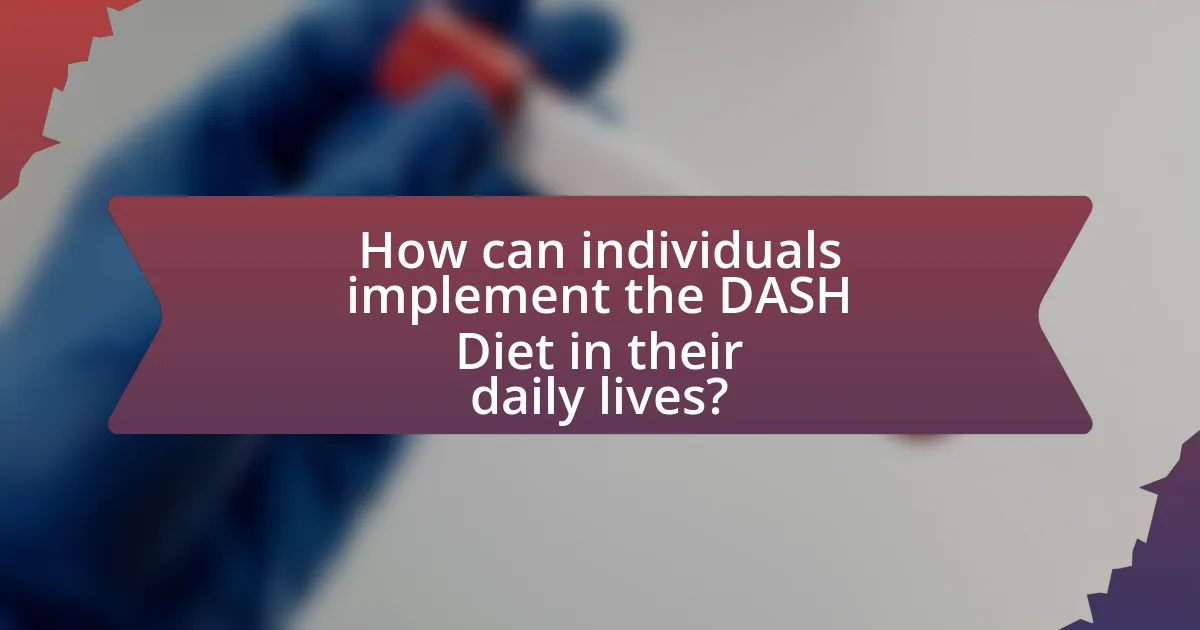
How can individuals implement the DASH Diet in their daily lives?
Individuals can implement the DASH Diet in their daily lives by focusing on consuming a variety of nutrient-rich foods while reducing sodium intake. This involves incorporating fruits, vegetables, whole grains, lean proteins, and low-fat dairy into meals, while limiting processed foods high in salt and sugar. Research indicates that following the DASH Diet can lower blood pressure and improve heart health, as evidenced by a study published in the New England Journal of Medicine, which found that participants who adhered to the diet experienced significant reductions in systolic and diastolic blood pressure. By planning meals around these food groups and gradually reducing sodium intake to 2,300 mg per day or ideally 1,500 mg, individuals can effectively adopt the DASH Diet for better hypertension management.
What practical steps can be taken to start the DASH Diet?
To start the DASH Diet, individuals should focus on incorporating more fruits, vegetables, whole grains, and lean proteins into their meals while reducing sodium intake. This diet emphasizes consuming at least 4-5 servings of fruits and vegetables daily, 6-8 servings of whole grains, and 2 or fewer servings of lean meats, poultry, or fish. Additionally, limiting sodium to 2,300 mg per day, or ideally 1,500 mg for greater blood pressure reduction, is crucial. Research indicates that following the DASH Diet can lower blood pressure significantly, with studies showing reductions of 8-14 mmHg in systolic blood pressure among participants.
How can meal planning support adherence to the DASH Diet?
Meal planning supports adherence to the DASH Diet by providing structured guidance on food choices that align with its principles. This structured approach helps individuals consistently select nutrient-rich foods, such as fruits, vegetables, whole grains, and lean proteins, which are essential for managing hypertension. Research indicates that individuals who engage in meal planning are more likely to meet dietary recommendations, as it reduces impulsive eating and enhances the likelihood of preparing healthy meals at home. Furthermore, a study published in the Journal of Nutrition found that meal planning is associated with improved dietary quality and adherence to dietary guidelines, reinforcing its effectiveness in supporting the DASH Diet.
What are some easy recipes that align with the DASH Diet?
Some easy recipes that align with the DASH Diet include a quinoa salad with mixed vegetables, baked salmon with herbs, and a vegetable stir-fry with brown rice. Quinoa salad combines whole grains, vegetables, and healthy fats, providing essential nutrients while being low in sodium. Baked salmon is rich in omega-3 fatty acids and can be seasoned with herbs instead of salt, promoting heart health. Vegetable stir-fry utilizes a variety of colorful vegetables and brown rice, offering fiber and vitamins while adhering to DASH guidelines by minimizing added sugars and unhealthy fats. These recipes support the DASH Diet’s focus on fruits, vegetables, whole grains, and lean proteins, which are effective in managing hypertension.
What challenges might one face when adopting the DASH Diet?
One challenge individuals may face when adopting the DASH Diet is the significant shift in dietary habits, which can lead to difficulties in meal planning and preparation. This diet emphasizes fruits, vegetables, whole grains, and lean proteins while reducing sodium intake, which may require individuals to change their shopping habits and cooking methods. Research indicates that many people struggle with the initial transition due to a lack of familiarity with these food groups and how to incorporate them into daily meals. Additionally, the DASH Diet may be perceived as restrictive, making it harder for some to adhere to long-term, especially if they are accustomed to a diet high in processed foods and sodium.
How can individuals overcome common obstacles to following the DASH Diet?
Individuals can overcome common obstacles to following the DASH Diet by planning meals in advance, incorporating a variety of foods, and gradually making dietary changes. Meal planning helps individuals avoid impulsive eating and ensures they have DASH-compliant options readily available. Including a wide range of fruits, vegetables, whole grains, and lean proteins can prevent monotony and increase adherence to the diet. Gradually introducing these changes allows individuals to adjust their taste preferences and habits without feeling overwhelmed. Research indicates that structured dietary interventions, such as those used in the DASH study, significantly improve adherence and health outcomes, demonstrating the effectiveness of these strategies in managing hypertension.
What strategies can help maintain motivation while on the DASH Diet?
To maintain motivation while on the DASH Diet, setting specific, achievable goals is essential. Research indicates that individuals who establish clear objectives are more likely to adhere to dietary changes. Additionally, tracking progress through food diaries or apps can reinforce commitment, as studies show that self-monitoring leads to better outcomes in dietary adherence. Engaging in meal planning and preparation can also enhance motivation by making healthy choices more convenient and enjoyable. Furthermore, seeking social support from friends, family, or online communities can provide encouragement and accountability, which has been shown to improve adherence to dietary regimens.
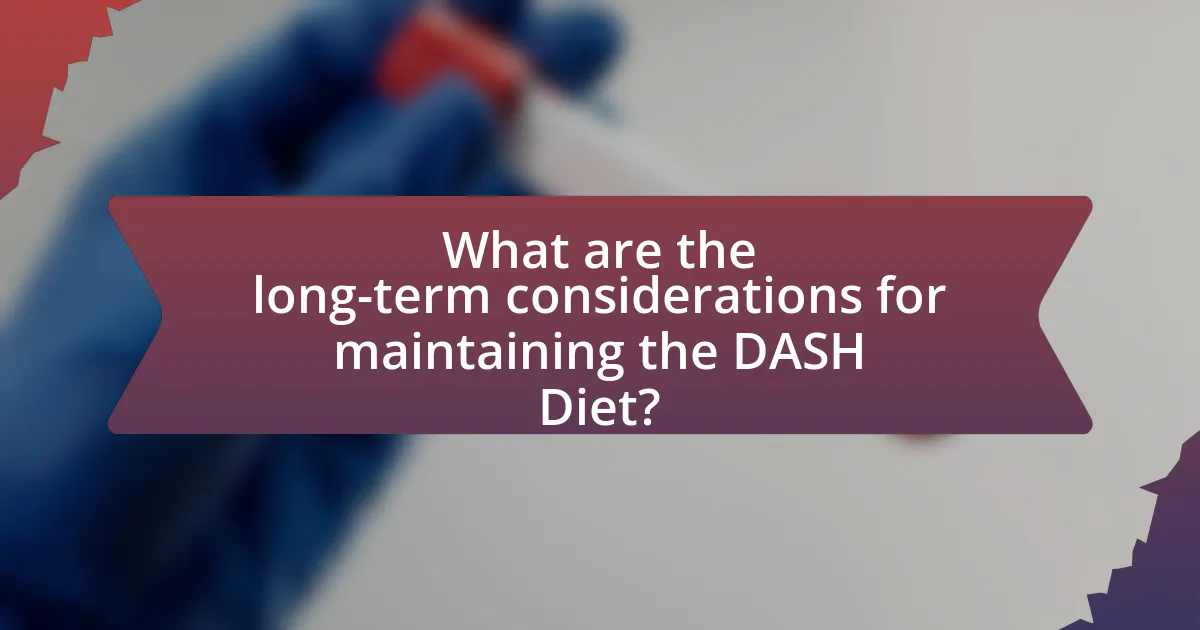
What are the long-term considerations for maintaining the DASH Diet?
Long-term considerations for maintaining the DASH Diet include consistent adherence to dietary guidelines, regular monitoring of blood pressure, and making sustainable lifestyle changes. Adhering to the DASH Diet requires a commitment to consuming a variety of fruits, vegetables, whole grains, lean proteins, and low-fat dairy while limiting sodium intake to 2,300 mg per day or ideally 1,500 mg for greater blood pressure reduction. Regular monitoring of blood pressure helps assess the effectiveness of the diet and allows for timely adjustments. Sustainable lifestyle changes, such as incorporating physical activity and managing stress, further enhance the benefits of the DASH Diet, contributing to long-term health improvements and hypertension management.
How can the DASH Diet be adapted for different lifestyles?
The DASH Diet can be adapted for different lifestyles by customizing meal plans to fit individual preferences, dietary restrictions, and daily routines. For instance, busy professionals can incorporate quick, healthy snacks and meal prep strategies to ensure adherence, while families can modify recipes to include kid-friendly options that still meet DASH guidelines. Additionally, individuals with specific dietary needs, such as vegetarians or those with gluten intolerance, can substitute animal proteins with plant-based sources and gluten-free grains, respectively, while maintaining the diet’s focus on fruits, vegetables, whole grains, and low-fat dairy. This flexibility allows the DASH Diet to be effective across various lifestyles, promoting better adherence and health outcomes.
What modifications can be made for vegetarian or vegan diets?
Vegetarian or vegan diets can be modified by incorporating plant-based sources of protein, such as legumes, tofu, and tempeh, to ensure adequate protein intake. Additionally, these diets can include a variety of whole grains, fruits, and vegetables to meet nutritional needs while adhering to the principles of the DASH diet, which emphasizes low sodium and high potassium intake for hypertension management. Research indicates that plant-based diets can lower blood pressure, as evidenced by a study published in the Journal of the American Heart Association, which found that vegetarian diets can significantly reduce systolic and diastolic blood pressure levels.
How can the DASH Diet be integrated into family meals?
The DASH Diet can be integrated into family meals by incorporating more fruits, vegetables, whole grains, and lean proteins while reducing sodium intake. Families can start by planning meals that feature a variety of colorful vegetables and fruits, such as salads or stir-fries, which align with the DASH Diet’s emphasis on nutrient-rich foods. Additionally, using herbs and spices instead of salt for flavoring can help maintain the diet’s low-sodium requirement. Research indicates that families who adopt these practices can significantly improve their overall dietary quality, which is essential for managing hypertension effectively.
What resources are available for those interested in the DASH Diet?
The resources available for those interested in the DASH Diet include official dietary guidelines, cookbooks, online meal planners, and support groups. The National Heart, Lung, and Blood Institute provides comprehensive information on the DASH Diet, including sample meal plans and recipes. Additionally, various cookbooks specifically focused on the DASH Diet offer practical recipes and tips for meal preparation. Online platforms, such as DASH Diet websites and apps, provide meal planning tools and community support, enhancing adherence to the diet. Research published in the “American Journal of Hypertension” indicates that the DASH Diet effectively lowers blood pressure, reinforcing the importance of these resources for individuals seeking to manage hypertension.
Where can individuals find support groups or online communities for the DASH Diet?
Individuals can find support groups or online communities for the DASH Diet on platforms such as Facebook, Reddit, and specialized health forums. These platforms host various groups dedicated to the DASH Diet, where members share experiences, recipes, and tips for adhering to the diet. For instance, Facebook has multiple groups focused on the DASH Diet, allowing users to connect with others following the same dietary guidelines. Additionally, Reddit features subreddits like r/DASHDiet, where users can engage in discussions and seek advice. These online communities provide valuable resources and support for individuals looking to manage hypertension through the DASH Diet.
What books or websites provide reliable information about the DASH Diet?
The book “The DASH Diet Action Plan” by Marla Heller provides reliable information about the DASH Diet, detailing meal plans and recipes. Additionally, the website of the National Heart, Lung, and Blood Institute (NHLBI) offers comprehensive resources on the DASH Diet, including guidelines and research findings. Both sources are recognized for their accuracy and evidence-based information on dietary approaches to manage hypertension.
What tips can help ensure success with the DASH Diet?
To ensure success with the DASH Diet, individuals should focus on incorporating a variety of fruits, vegetables, whole grains, and lean proteins into their daily meals. This diet emphasizes reducing sodium intake to less than 2,300 milligrams per day, which has been shown to lower blood pressure effectively. Additionally, meal planning and preparation can help maintain adherence to the diet, as it allows for better control over ingredients and portion sizes. Research indicates that following the DASH Diet can lead to significant reductions in hypertension, with studies showing a decrease in systolic blood pressure by an average of 5 to 6 mmHg.
